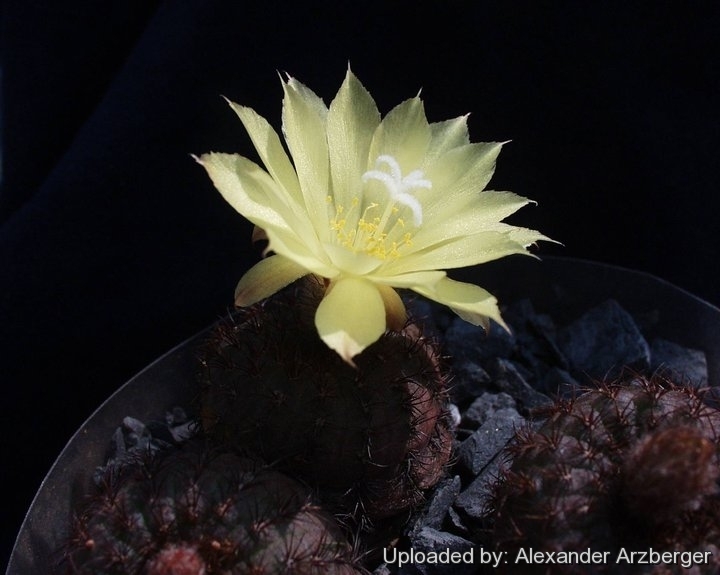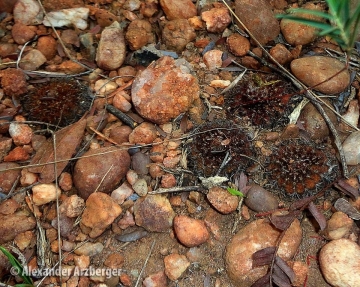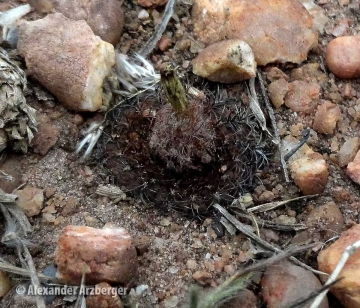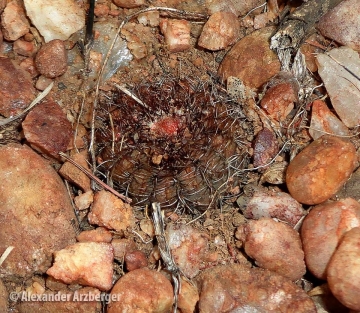= Frailea matoana Buining & Bredero
Cact. Succ. J. (Los Angeles) 43(4): 139. 1971
Accepted Scientific Name: Frailea cataphracta subs. duchii (G.Moser) P.J.Braun & Esteves
Succulenta (Netherlands) 74: 130 1995

Frailea schilinzkyana subs. matoana (Frailea matoana) Photo by: Alexander Arzberger
Origin and Habitat: Sierra de Maracaju, Maneco to Limaira (municípios de Antonio João), southern part of Mato Grosso do Sul, Brazil (near the border with Paraguay)
Altitude: 270-720 metres above sea level.
Habitat and ecology: Frailea matoana, which was already declared as extinct by Pierre Braun, still grows among boulder exclusively in the highest places of small hills. The scarce vegetation consists of grass and some small bushes limited in their growth by very scarce soil nutrients. The substrate is sandy-clayey and fairly compact. It is very difficult to find these little plants when do not in bloom, they also grow solitary and very scattered. The weather is quite hot and humid throughout the year. However, this Frailea is quite delicate and doesn't like high humidity.
Synonyms:
See all synonyms of Frailea cataphracta
back
Accepted name in llifle Database:Frailea cataphracta (Dams) Britton & RoseCactaceae (Britton & Rose) 3: 210. 1922 [12 Oct 1922]Synonymy: 3
Accepted name in llifle Database:Frailea cataphracta subs. duchii (G.Moser) P.J.Braun & EstevesSucculenta (Netherlands) 74: 130 1995Synonymy: 11
Accepted name in llifle Database:Frailea cataphracta subs. tuyensis (Buining & G.Moser) P.J.Braun & EstevesSucculenta (Netherlands) 74: 130 1995.Synonymy: 5
back
Description: Frailea matoanaSN|3650]]SN|3650]] is generally included within (as a synonym of) Frailea cataphractaSN|3597]]SN|3597]] subs. duchii, suggesting that there is not really a fundamental difference between the two, and hard to name accurately without knowing where they come from, and there remains a considerable confusion surrounding the true identity of this this plant.
Distinguishing characteristics. Frailea matoanaSN|3650]]SN|3650]] is a very small depressed cactus to only 25 mm diameter and 11 mm high that, despite belonging to the "cataphracta" group, has reddish to dark brown body with 15 ribs, areoles with brown or blackish spines to 4 mm long, and yellow flower. Usually it do not sprout in nature, but in culture with age begins to clump around the base and grow oddly.
Derivation of specific name: “matoana” for the occurrence in the State of Mato Grosso do Sul, Brazil.
Stem: Globose, deeply imbilicate at apex, to only 25 mm diameter, reddish, dark dirty bronze or dark brown.
Roots: Branched.
Ribs: About 15, vertical, 4-5 mm wide, divided by transverse minute furrows into small square, globular tubercles.
Areoles: With conspicuous dirty white wool when young contrasting strongly with the dark body, later bare, c. 2 mm apart.
Radial spines: Small. 4 more or less pectinate, on both sides, 1 or 2 pointing downwards, often 1-2 smaller upper ones up to 4 mm long, not much adpressed curved inward, shining, reddish-brown to almost black, deciduous or persistent.
Central spines: Absent (or occasionally 1 short and straight)
Flowers: Funnel-shaped 21 mm long, 20 mm wide, sulphur yellow from the top of the plant, sometimes larger than the plant itself. Pericarpel 6 mm long, 5 mm broad, naked beneath, but with whitish to orangish hairs above. Receptacle 5-6 mm long, hairs whitish to orangish. Outer perianth segments pale yellow, spathulate, acute, the tip slightly toothed and pinkish. Style 12 mm tall, yellowish-white. Stigma-lobes 8, 3 mm long, white. Filaments in two rows, primary filament pale yellow 7 mm long inserted at the base of the style; Secondary 6 mm long, parietal, yellow. Anthers to 0.8 mm long, yellow. Nectar chamber of 0.4 mm wide. But don't be disappointed when the easily produced buds fail to open. Fraileas are cleistogamous meaning that their flowers produce seed without even opening. Without the need for pollination, hence the buds rarely reach full bloom and remain closed. They will open only in great heat in the hottest, brightest, afternoon sun, if at all.
Fruits: Round more or less flattened, 6-7 mm in diameter, tawny brown, dry indehiscent with scales and bristles that detach easily, pericarp membranous, fragile that break easily releasing the seed and the flower remains are persistent.
Seeds: Boat-shaped, 2.1-2.2 mm long, 1.8 mm broad, comparatively large, chestnut-brown, and shining reticulate. Hilum oblong-round.
Subspecies, varieties, forms and cultivars of plants belonging to the Frailea cataphracta group
 Frailea cataphracta (Dams) Britton & Rose: (subsp. cataphracta), has dull green bodies with few (8-15) ribs, spine to 2 mm addpressed, centrals absent. Distribution: Bolivia and Paraguay.
Frailea cataphracta (Dams) Britton & Rose: (subsp. cataphracta), has dull green bodies with few (8-15) ribs, spine to 2 mm addpressed, centrals absent. Distribution: Bolivia and Paraguay. Frailea cataphracta subs. duchii (G.Moser) P.J.Braun & Esteves: has dirty bronze bodies with less than 18 ribs, spines to 4 mm, centrals absent or 1-2. Distribution: southeast of Asuncion, Paraguay.
Frailea cataphracta subs. duchii (G.Moser) P.J.Braun & Esteves: has dirty bronze bodies with less than 18 ribs, spines to 4 mm, centrals absent or 1-2. Distribution: southeast of Asuncion, Paraguay. Frailea cataphracta subs. melitae (Buining & Bredero) P.J.Braun & Esteves: (F. cataphracta subs. duchii) has less than 21 flattened, but noticeably tuberculate ribs. Distribution: Mato Grosso, Brazil
Frailea cataphracta subs. melitae (Buining & Bredero) P.J.Braun & Esteves: (F. cataphracta subs. duchii) has less than 21 flattened, but noticeably tuberculate ribs. Distribution: Mato Grosso, Brazil Frailea cataphracta subs. tuyensis (Buining & G.Moser) P.J.Braun & Esteves: has less than 20 ribs. Distribution: Paraguay.
Frailea cataphracta subs. tuyensis (Buining & G.Moser) P.J.Braun & Esteves: has less than 20 ribs. Distribution: Paraguay. Frailea cataphractoides Backeb.: (F. cataphracta subs. duchii) has greyish-olive-green bodies (purplish to black in full sun) with very closely set brown areoles and spines up to 4 mm long. Distributiin: Bolivia.
Frailea cataphractoides Backeb.: (F. cataphracta subs. duchii) has greyish-olive-green bodies (purplish to black in full sun) with very closely set brown areoles and spines up to 4 mm long. Distributiin: Bolivia. Frailea matoana Buining & Bredero: (F. cataphracta subs. duchii) has reddish to dark brown body with 15 ribs, areoles with brown or blackish spines to 4 mm long. Distribution: municípios de Antonio João, Mato Grosso do Sul, Brazil
Frailea matoana Buining & Bredero: (F. cataphracta subs. duchii) has reddish to dark brown body with 15 ribs, areoles with brown or blackish spines to 4 mm long. Distribution: municípios de Antonio João, Mato Grosso do Sul, Brazil Frailea uhligiana Backeb. in Backeb.: (F. cataphracta subs. duchii) has green to bronze bodies with up to 25 ribs and less adpressed spines up to 4 mm long. Distribution: San Jose between Santa Cruz and Corumba, Bolivia.
Frailea uhligiana Backeb. in Backeb.: (F. cataphracta subs. duchii) has green to bronze bodies with up to 25 ribs and less adpressed spines up to 4 mm long. Distribution: San Jose between Santa Cruz and Corumba, Bolivia.
Bibliography: Major references and further lectures
1) Clive Innes “Complete Handbook of Cacti and Succulents” Van Nostrand Reinhold Company, 01 December 1981
2) Jardín Urumbé Cultivo de Cactus y otras Suculentas “Una pequeña joya – Frailea matoana (AA162)” retrieved on 25 June 2016 from <https://urumbe.wordpress.com/2010/03/15/una-pequena-joya-frailea-matoana-aa162/>
3) Paul C. Laney Frailea - Hidden treasures “Frailea matoana” retrieved on 25 June 2016 from <http://www.frailea.com/Species/Frailea_matoana.htm>
4) “Alweer een artikel over Frailea's.” J.J. De Morree, in Succulenta (Netherlands) 68(5): 100-103, 1989.
5) “Frailea matoana Buining & Brederoo Sp. Nov. A. F. H. Buining.” in Cactus and Succulent Journal Vol. XLIII (4): 139-142, 1971
6) “Frailea’s ook in Paraguay.” Ludwig Bercht & Volker Schädlich. In Succulenta (Netherlands) 87(1):36-42. 2008.
7) Edward Anderson “The Cactus family” Timber Press, Incorporated, 2001
8) David R Hunt; Nigel P Taylor; Graham Charles; International Cactaceae Systematics Group. "The New Cactus Lexicon" dh books, 2006
9) Marlon C Machado “Fascinating Frailea, Part 2: Review of the species from Rio Grande do Sul” Cactus World (BCSS) Volume 25 No. 2 June 2007
 Habitat. Near Antonio Joao, Mato Grosso do Sul, Brasil. (Frailea matoana) Photo by: Alexander Arzberger
Habitat. Near Antonio Joao, Mato Grosso do Sul, Brasil. (Frailea matoana) Photo by: Alexander Arzberger Frailea schilinzkyana subs. matoana (Frailea matoana) Photo by: Alexander Arzberger
Frailea schilinzkyana subs. matoana (Frailea matoana) Photo by: Alexander Arzberger Frailea schilinzkyana subs. matoana (Frailea matoana) Photo by: Alexander Arzberger
Frailea schilinzkyana subs. matoana (Frailea matoana) Photo by: Alexander Arzberger Near Antonio Joao, Mato Grosso do Sul, Brasil. (Frailea matoana) Photo by: Alexander Arzberger
Near Antonio Joao, Mato Grosso do Sul, Brasil. (Frailea matoana) Photo by: Alexander ArzbergerCultivation and Propagation: Frailea matoanaSN|3650]]SN|3650]] is a summer grower species relatively easy to grow. It is sometime seen as a grafted plant but grows very well on its own roots too. Characteristically, during the dry season plants retract completely under the ground both in the wild and in cultivation too.
Growth rate: Fraileas are relatively short-lived plants, only lasting few years (rarely more than 10-15 years in cultivation) and, possible annuals in habitat! In fact they reseed readily around the base of the mother plant from self-set seed if kept reasonably moist during warm weather. It is a
good idea to keep restarting them from seed; what looks like a healthy big plant may suddenly die of old age without warning.
Soil: Use mineral well permeable substratum with little organic matter (peat, humus), plants may become too elongated if compost is too rich.
Repotting: Re-pot every 2 years. Use pot with good drainage.
Fertilization: It grows much faster with a low nitrogen content fertilizer in spring and summer. Potassium helps maintaining the plants compact and healthy.
Watering: Requires careful watering to keep plant compact. Water sparingly from March till October, the thin, fibrous roots suffer if there is humidity, therefore the plant should be watered only when the surrounding terrain is dry. Keep dry as soon as the temperature starts dropping in October and keep it perfectly dry in winter at temperatures from 5 to 15 degrees centigrade.
Hardiness: They need a minimum temperature of 5-10° C (but occasionally temperatures of a few degrees below 0° are not dangerous if kept on the dry side prior to, and during, cold weather). It tends to rot in winter during the resting phase, if kept wet. In the rest period no high atmospheric humidity!!
Sun Exposure: Light shade to full sun, its colour tends to richer and darker when grown in light shade. In a shaded position the plants grow faster, but are not flat shaped and dark coloured.
Uses: It is an excellent plant for container growing. It always looks good and stays small.
Pests & diseases: It may be attractive to a variety of insects, but plants in good condition should be nearly pest-free, particularly if they are grown in a mineral potting-mix, with good exposure and ventilation. Nonetheless, there are several pests to watch for:
- Red spiders: Red spiders may be effectively rubbed up by watering the infested plants from above.
- Mealy bugs: Mealy bugs occasionally develop aerial into the new growth among the wool with disfiguring results, but the worst types develop underground on the roots and are invisible except by their effects.
- Scales: Scales are rarely a problem.
- Rot: Rot is only a minor problem with cacti if the plants are watered and “aired” correctly. If they are not, fungicides won't help all that much. To prevent rottenness it is also advisable to surround its root neck by very rough sand or grit, this help a fast water drainage.
Propagation: With fresh harvested seeds or (rarely) by grafting. Fraileas set seed (when well grown) and grow easily from seed. In fact, they are reported to set seed even if the flower doesn’t open. This self-fertilization is called cleistogamy. Seedlings dislike strong light and dry conditions and need to be repotted frequently during the first few years. However, old plants become senile and have a tendency to succumb to disease and a weak root system. At this stage, as is well known, they die suddenly. So, after they reach about 4-5 cm in diameter grow them slowly, and adopt a new repotting period, using intervals of every 3-4 years. Additionally grow them under drier conditions or with stronger sunlight. But plants are sometine grafted to accelerate growth, but the grafted plants are typical rather tall growing, compared with plants on their own roots that are usually more flat to the ground.














